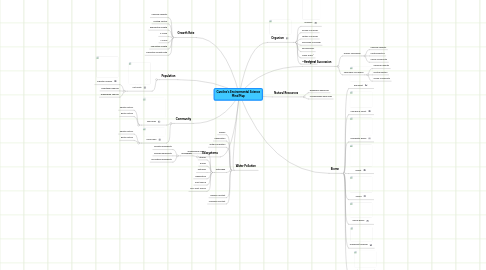Caroline's Environmental Science Mind Map
caroline kernにより


1. Population
1.1. Hot Spots
1.1.1. Indicator Species
1.1.2. Threatened Species
1.1.3. Endangered Species
2. Community
2.1. Food Web
2.1.1. Abiotic Factors
2.1.2. Biotic Factors
2.2. Food Chain
2.2.1. Abiotic Factors
2.2.2. Biotic Factors
3. Ecosystems
3.1. Biodiversity
3.1.1. Genetic Biodiversity
3.1.2. Species Biodiversity
3.1.3. Ecosystem Biodiversity
4. Growth Rate
4.1. Carrying Capacity
4.2. Limiting Factors
4.3. Exponential Growth
4.4. S-Curve
4.5. J-Curve
4.6. Population Growth
4.7. Population Growth Rate
5. Water Pollution
5.1. Aquifer
5.2. Desalination
5.3. Water Purification
5.4. Watershed
5.4.1. Impermeable surface
5.4.2. Erosion
5.4.3. Runoff
5.4.4. Wetlands
5.4.5. Urbanization
5.4.6. Point source
5.4.7. Non-Point Source
5.5. Organic Pollutant
5.6. Inorganic Pollutant
6. Biome
6.1. Rainforest
6.2. Coniferous Forest
6.3. Freshwater Biome
6.4. Desert
6.5. Tundra
6.6. Marine Biome
6.7. Grassland/Savannah
6.8. Temperate Deciduous Forest
7. Organism
7.1. Producer
7.2. Primary Consumer
7.3. Tertiary Consumer
7.4. Secondary Consumer
7.5. Decomposers
7.6. Tropic levels^
7.7. Pioneer Species
8. Ecolgical Succession
8.1. Primary Succession
8.1.1. Carrying Capacity
8.1.2. Limiting Factors
8.1.3. Climax Community
8.2. Secondary Succession
8.2.1. Carrying Capacity
8.2.2. Limiting Factors
8.2.3. Climax Community
